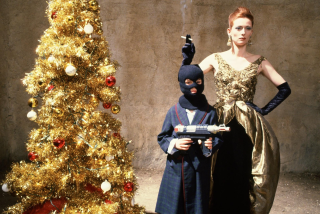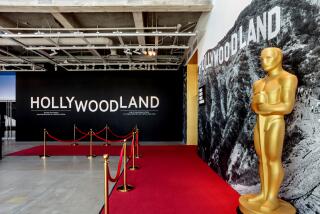Great Read: Silent-movie buffs search the screen for clues to origins of ‘Mostly Lost’ films
- Share via
Beneath glimmering chandeliers at an Art Deco movie house built into the side of a mountain, 150 silent-movie buffs sat wide-eyed as snippets from films lost decades ago lighted up the screen.
Their quest: Name the film, or at least spot details that will advance the cause.
The fans shouted clues as a piano player wearing an old-time parlor vest and a thick period mustache improvised jaunty scores. They scoured vintage magazines on their laptops, checked film databases on their tablets, and scrubbed their brains for odd bits of early 20th century cultural history.
Every frame had the potential to unlock a secret.
“East Coast vegetation!” someone yelled, shortly after a brief segment of a Western began.
A locomotive flashed, and someone deduced that a scene had been filmed in France, given the placement of the boiler. When dialogue titles popped up on another clip, a viewer guessed that it was produced by Thomas Edison’s studio because of the distinctive font.
And then there was the lucky glimpse of a calendar with a key nugget — the date April 1 falling on a Saturday. That movie was probably shot in 1922, a fan surmised, based on a quick online search of old calendars.
This was the “Mostly Lost” film festival, which has become a pilgrimage for a subset of movie fans who revere the era long before the advent of computer-enhanced animatronic dinosaurs.
For four years, the event at the State Theatre on the Library of Congress’ Packard Campus has attracted historians with advanced degrees, old men with stacks of even older film tins in their basements and self-taught aficionados who can quickly determine a car’s model year or identify a never-famous actor by the shape of his posterior. This year, an 11-year-old boy, who has appeared on Turner Classic Movies to introduce Charlie Chaplin’s “Modern Times,” missed two days of school to be here.
What they all had in common was an obsession with a time when movies were made without color, sound or social media campaigns.
The Packard Campus, about 90 minutes from Washington, D.C., near the foothills of the Blue Ridge Mountains, houses the largest and most comprehensive film collection in the world.
The 125 films screened over three days in June were mere fragments — five- to 10-minute clips — mostly from movies so obscure that even top film archivists could not decipher the titles, name the actors, or determine the year they were made.
The clue from the 1922 calendar turned out to be a clincher. It matched the film to a publicity photograph — found in an online database called Lantern — from a film called “Small Town Hero,” which involved a woman who works alongside a chimpanzee at a general store. (Chimpanzees show up often in silent movies, as do men in bowler hats.)
Movies like this are unlikely to be revered alongside Chaplin classics, even after they are identified. Many, after all, were forgotten for a reason.
“Very few of them will ever make it to an audience,” said Serge Bromberg, a 54-year-old Parisian who owns Lobster Films, a company that restores, sells and shows old films and who regularly screens movies here. “We are the unique animals who will watch these films.”
::
Identifying films is only part of the draw. Silent-movie buffs get a chance to mingle with other film nerds and tour the library, with its 7 million films, television programs, and radio broadcasts and other sound recordings stored in bins, shelves and vaults.
The facility, a former Federal Reserve bunker that once held $3 billion in emergency coin and currency, opened in 2007 after tech heir David W. Packard spent $155 million to buy and renovate it before turning it over to the federal government. Usually, only the theater is open to the public.
The fans wandered among bankers boxes of films, past giant contraptions used to clean and preserve them. They gasped as they watched a technician unspool and clean a rare copy of Buster Keaton’s “Sherlock Jr.”
Shane Fleming, the 11-year-old, has his own business card — “Film Director, Writer, Actor, and Historian.” He shrieked as he walked through a vast corridor of nitrate film, a highly flammable material kept in 39-degree cells and fire-resistant vaults. He snapped pictures of the only known remaining nitrate copy of a 1910 version of “Frankenstein,” made by Edison’s film company.
Shane nearly fell over when Rob Stone, the moving-image curator at the Library of Congress, let him touch the original camera negative of “The Great Train Robbery” from 1903.
Stone also let the group in on secrets, like the Jerry Lewis collection he had just acquired on behalf of the library.
Did he really have the film negative of “The Day the Clown Cried,” an unreleased Holocaust comedy that Lewis regretted making? Yes, Stone said, but the library agreed to not show the film for at least 10 years.
After the library tour and in between screening lost films, the group attended lectures that would enhance their ability to name antique films. “The Mystery of the Second Camera” detailed why some prints from silent-era films look different from one another. The foreign copies were usually shot by a second cameraman, who stood just behind the primary camera.
::
The State Theatre was built to resemble some of the great movie houses of the West Coast. The crowd walked over floral carpets that replicate those in the Stanford Theatre in Palo Alto. They sunk into deep red-velvet seats, beside swaths of peach-colored Italian wall coverings, below the ornate chandeliers that pay homage to the Warner Grand Theatre in San Pedro.
“There are a lot of films we’re going to screen that are completely out of order and just jump around,” said Rachel Parker, a moving-image technician at the library. “That’s part of the fun.”
Then the films began.
“I think it’s Charlotte Burton on the left,” a man shouted, as if faintly recognizing a friend. Then he corrected himself, saying it had to be Rhea Mitchell, another actress unknown even to some in the room.
“‘Philip Holden — Waster,’ 1916,” someone said, giving one film’s title and the year it was made. An Oct. 13, 1916, review from Variety — with details about the plot, characters and actors — seemed to confirm the guess. Yes, everyone agreed, before clapping.
The selections included a notable sampling of the bizarre, including a short clip of two dancing clowns with long, spindly arms and another of a mischievous little boy with cartoonishly thick makeup. Neither was identified.
When jumbled segments of an American Legion promotional film rolled, one of the viewers announced that he was contacting the veterans organization’s head archivist, who had what appeared to be different segments from the same film. Others clicked news archives to confirm that the Herbert Hoover footage probably came from the Legion’s 1931 convention in Detroit.
When another film showed a road sign for a Blomerth Street, someone found the location on Google Earth — in Malden, Mass., about 30 miles south of a defunct film studio in Lowell.
“You never know what people are going to know that can really help,” said Steve Massa, a librarian at the New York Public Library for the Performing Arts.
Massa is a legend of the conference, best known for an incident last year when he named a rotund silent actor after watching just a few frames of him — shot from behind.
“I yelled out, ‘It’s Henry Bergman,’ before he turned around,” Massa recalled.
Massa had at the time been on the lookout for Bergman, a silent actor who later became an assistant to Chaplin.
Only about a quarter of the 125 films were identified during this conference. Some would remain mysteries for the foreseeable future. Others would be identified in the coming weeks; the clues gathered here are shared on a website for film archivists. In previous years, more than half of the clips were eventually matched to a title.
The annual event was hatched by Parker along with Stone, who says he has long been driven crazy by the cans of unknown films that would stack up in his old job as associate curator at the UCLA Film & Television Archive. About 70% of films from the silent era are believed to be lost, according to a 2013 study.
Admirers of these films not only love watching them — the primal physical comedy of Keaton, the sometimes clumsy attempts to push the boundaries of technology in “Metropolis,” the sublime moments of discovery in Lillian Gish’s “The Wind.” They also value them as windows into history.
“We all started when we were young and there were not so many television shows dedicated to classic films,” said Bromberg, the Frenchman, who owns about 150,000 films and opened Cannes Film Festival four years ago with a restored version of a revered 1902 fantasy film called “A Trip to the Moon.”
During a break between screenings and lectures, Steve Wiener, a retired Cal State San Marcos media technician, mingled in the theater lobby near framed posters advertising Frank Capra’s “Meet John Doe” and Barbara Stanwyck in “Double Indemnity.”
For a moment, Wiener was transported to his childhood, and the first silent films he saw at a theater on Fairfax Avenue in Los Angeles. His father would take him to Canter’s Deli for pastrami or chopped liver. Then they’d watch Chaplin, Keaton, or Laurel and Hardy.
He’d buckle over laughing until it hurt.
Twitter: @noahbierman
SIGN UP FOR OUR NEWSLETTERS
Get your free weekly dose of Classic Hollywood >>
Get the best of the Times’ storytelling weekly >>
More to Read
Sign up for Essential California
The most important California stories and recommendations in your inbox every morning.
You may occasionally receive promotional content from the Los Angeles Times.











